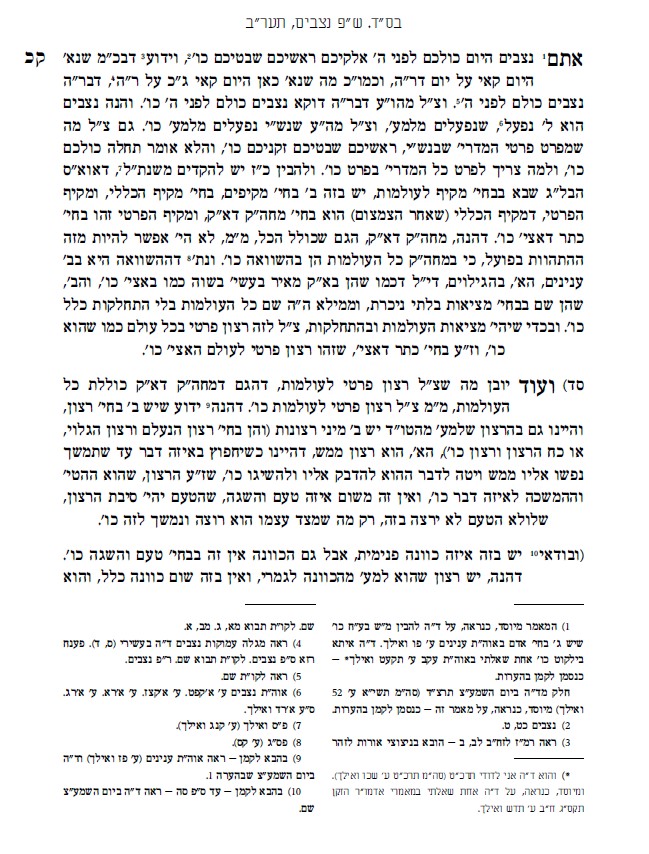AYIN BEIS | Existence Unplugged
Chapter 64: Levels of Desire (part 2) – Revealed Desire
Short Summary
The need for a specific desire for each individual world can be further understood by knowing that there are two levels of desire: actual desire which is palpably drawn to the objective of creating existence. (Lower than essential desire, like that of parent to child, G-d and souls, which has no objective at all, and is only an expression of their essential connection, regardless of revelation or quality, unlike the desire for — and pain from concealed — divine revelation).
Long Summary
To further understand why there needs to be a specific desire for each individual world (even though the primordial desire of A”K encompasses all of existence): There are two stages of desire: 1) The power of desire (or unrevealed desire), and 2) actual desire (or revealed desire).
The first is an actual will, which means desiring a particular objective, to the point that his spirit is palpably drawn to it, to bind with and acquire it. This is the definition of desire (ratzon): being inclined and drawn on your own to any object (for no reason or explanation which compels the desire (and without the reason there would be no desire), only simply because he is so inclined).
[Once he is discussing desire that reflects the soul’s essence, he tangentially qualifies this with a discussion (in a long parentheses that concludes at the end of the chapter) about an even higher desire (essential desire) that has no objective and reason at all].
(There is certainly some inner objective to the desire. but this objective is not a rational one, unlike the essential desire (ratzon atzmi) which is utterly beyond any objective and purpose; this is the essential desire that is rooted in the essence, like the desire of a parent to a child and a child to parent (which at times emerges in strong yearnings for one another), which has is due to no objective at all, only to the fact that they are of one essence, inconsequential of the quality, personality and stature of the parent or child. This revealed desire is the expression and revelation of the essence itself. (The essence itself is transmitted and revealed in this expression).
This is an example above for the essential desire of the divine essence for souls, which has no objective at all, and is only due to the souls being rooted in the essence, not due to any reason or virtue. There is another powerful divine desire for divine revelation in the lowest of worlds (dirah b’tachtonim) and for Torah and mitzvot and the holy temple (and divine “pain” over the destruction of the temple and the concealed G-dliness in exile), but the divine desire and love for souls is not due to any revelation, but due to their essential connection, regardless of the revelation or quality of the expression. Which is why it says that even when souls are distant, “in the land of their enemies, I am not disgusted by them,” because “either this way or that way they are my children.”
Souls also have two similar levels of desire for the divine: 1) Due to its essence being rooted in Atzmus the soul has an essential desire for the divine for utterly no reason or objective or benefit. When the soul’s essence is revealed it is drawn to its source like a flame rising on is own. 2) The souls desire and thirst for divine revelation, which has an objective and goal. Even the soul’s desire for the essence and not for revelation (mi li b’shomayim) has an objective — either the desire for the revelation of the essence, or to be encompassed in the essence.
[Returning now to the initial topic, the first stage of desire, palatable and revealed yearning for any given object].
However, the discussion here is the desire that has some internal objective (unlike the above-mentioned essential desire that has no objective at all), though the desire is supra-rational. Above this is the divine desire to create existence, which has the inner purpose of G-d’s desire for a home in the lowest of worlds. This desire too has no reason and explanation, and is only because He so desires (but it does have an objective)).
Hebrew Text



Concepts
Actual Desire
Sources
Two levels of desire (ch. 64-66) — Drush Gimmel Minei Odom (Maamorei Admur HaZakon Inyonim p. 8-10. 15. 19. See also Bechukosei 5567 p. 409-410). With the Tzemech Tzedek’s additions – Ohr HaTorah Inyonim pp. 87 ch. 6-8. Siddur Im Dach Lamnatzayach al HaShminis 139d. Imrei Binah Shaar Ha’Keriyas Shema ch. 10. Shaar HaYichud ch. 10-11. 16. Odom Ki Yi’hiyeh Samach Vav (p. 197). Eter p. 28. 5692 pp. 68. BaSukkos Teishvu 5694 (pp. 52). 5710 (p. 60).
Analysis/Compendium
Based on this chapter there appears to be three types of desire: 1) A desire that is driven by a rational reason. 2) A supra-rational desire that has an objective, albeit one that has no reason or explanation. 3) An essential desire that is rooted in the essential connection between the one who desires and the object he desires (like a parent and child; G-d and souls), which has utterly no objective at all; it is simply an expression of the essential connection.
Why is it important to emphasize this distinction? Perhaps the explanation is as follows: The point in these chapters is to explain why there needs to be a specific desire (keser) for each individual world (which has a relationship with and impact on existence), because the primordial desire of A”K (the macro-cosmic makif/keser) that encompasses all of existence is still in a state of concealed desire, the determination and desire to desire, but it is not yet an actual desire for existence. Thus, the actual desire needs to include two elements to it: 1) A supra-rational element that is not bound to rational conditions which can change the desire (desire type #1 above), i.e. the supra-rational divine desire for existence. 2) An actual and palatable desire, not one that remains an abstract determination (like A”K), and one that has a defined objective (creation of existence), unlike the essential desire (type #3) that has no objective at all, and thus does not manifest as a level of desire that relates to existence (see earlier ch. xxx regarding the higher divine levels (the root of transcendent energy) that have no objective except revealing their source, while the root of immanent energy has the purpose to create and illuminate existence).

 Anchor
Anchor Breaker
Breaker Google Podcasts
Google Podcasts RadioPublic
RadioPublic Spotify
Spotify Pocket Casts
Pocket Casts